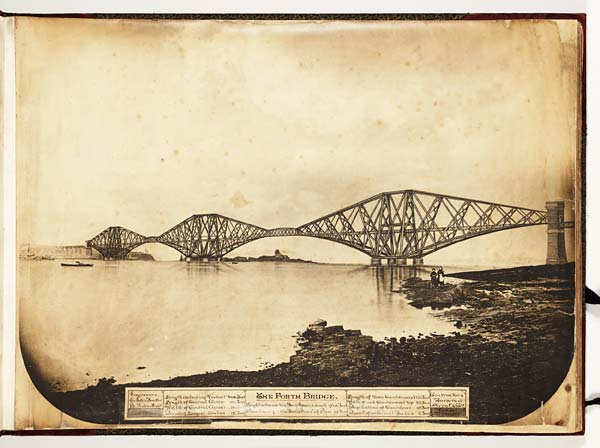Learning How to Open Up Data at the National Library of Scotland
Back in May 2012 I heard via Karen Coyle (who’s based in California) that there was an Open Knowledge Foundation Meet-up in a pub just 50 metres from my office at the National Library of Scotland in Edinburgh. It’s amazing how the web works! I had never heard of Open Knowledge Foundation before but given that I was trying to learn more about open data and had questions about how to publish data openly (and perhaps really because the meeting was in the pub …. mmm beer) I decided to attend.

Photograph of the Firth of Forth with artists’ imaginative depiction of the completed Forth Rail Bridge (1886)
At the meeting I learned a whole lot about open data initiatives in the city of Edinburgh, met many interesting people from all sorts of backgrounds who were working on open data, and drank some beer. But what I came away with which was most valuable to me and the National Library of Scotland was a promise from Naomi Lillie that she would put me in touch with a colleague at the Foundation who would help answer my questions about how to publish data openly.
Sam Leon dropped me a line and with his help I came to realise that publishing open data could be very easy and straightforward. Sam explained that we also needed to think about how we wanted to license our data, that it should be both structured and documented, and then we could publish it.
I decided that if National Library of Scotland was to dip its toe in the open data pool that we should start with a very small set of data. I chose the Library’s collection of 40 digitised photographs of the construction of the iconic and beautiful Forth Bridge. I could also readily put my hands on a version of the metadata that I could give to the world and give it to them NOW.
The main issue for the Library was addressing whether we could and should release the metadata associated with the collection under an open license. After discussions we decided that we could, in principle, publish metadata that had been created in the Library under CC0. We came to this conclusion because we think of our metadata as an advert for the Library’s resources. If we made metadata freely available to others to use, re-purpose, and develop and create new services it will “point back” to NLS resources. This could thus expose our collections to a wider audience and in more innovative ways that we could achieve ourselves.
So, we had a small set of metadata that was readily available, for which we were comfortable licensing under CC-0, it was also nicely structured and could be easily documented. We’ve now made it available via the Datahub which you can find here.
We have learned a lot from our collaboration and involvement with the Open Knowledge Foundation. They have helped me and National Library of Scotland understand clearly the benefits of releasing data openly to facilitate its reuse. As a result of our interaction, the Library will, in the coming months, work to develop policies relating to open data and in time plan to release more and larger collections of metadata as open data. Through Open Knowledge Foundation meet-ups we’ve had the opportunity to meet with colleagues in other organisations and discuss how we can work with them to collaborate on mutually beneficial open data projects. And then there’s the beer.
If you’re reading this and have been in the same position as me and National Library of Scotland and are wondering the how, the why and the wherefore of open data, I encourage you to contact the OpenGLAM team for their advice or seek out an Open Knowledge Foundation meet-up in your area. Because it’s time to let your data leave home and run free.
